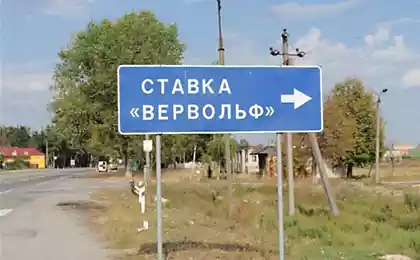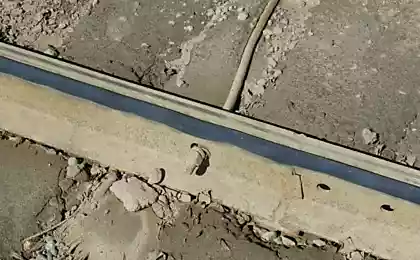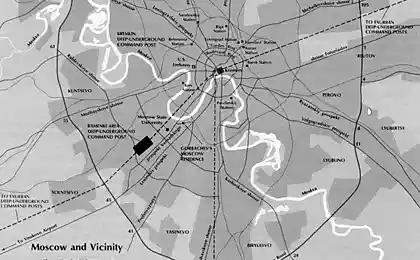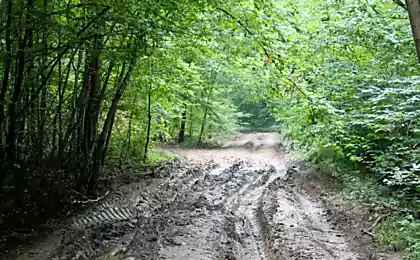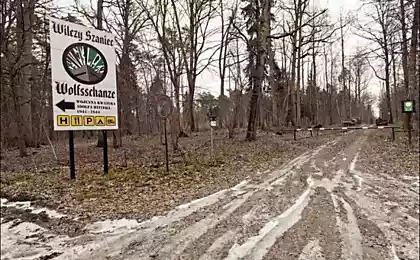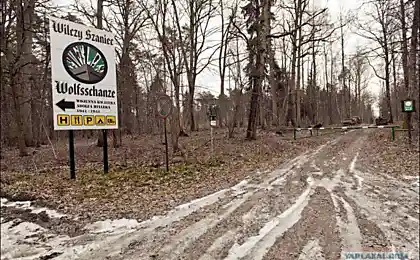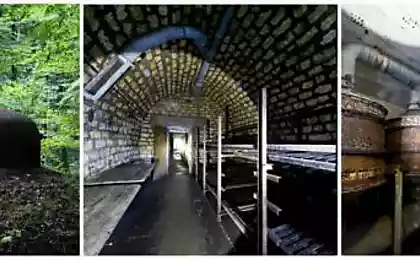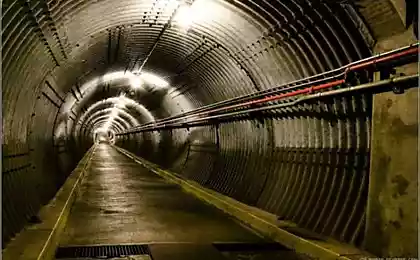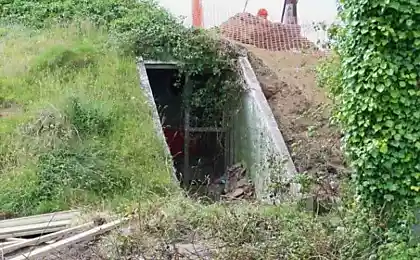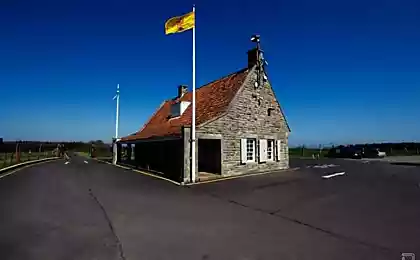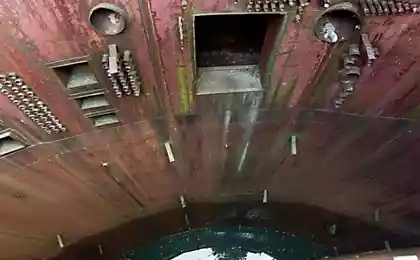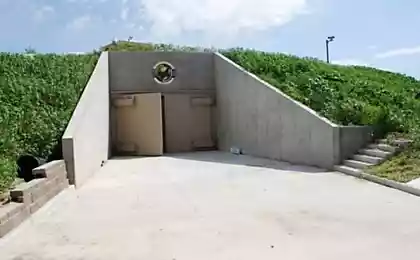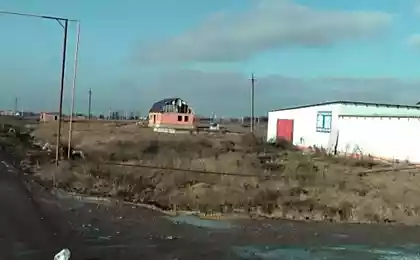2490
Stalin's bunker in Samara (18 photos)
"Stalin's Bunker" - colloquial name of a defensive structure in Samara, created as a backup location Supreme Commander of the Armed Forces of the USSR Stalin. Is located at a depth of 37 m. Built in 1942, declassified in 1990.

The object is located under the building of the Academy of contemporary art and culture, which previously housed the Kuibyshev Regional Committee. To the right of the main staircase in the lobby of the Regional Party Committee was inconspicuous door, near which the clock duty officer of the NKVD. Immediately after her iron leaf behind which was one of the main secrets of the time. Also, there is an entrance from the courtyard through which we entered.
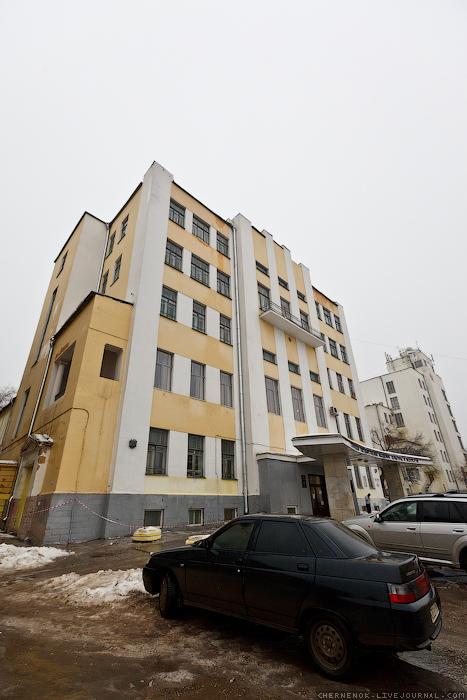
Stalin's bunker in Samara - the most powerful of the now declassified bunkers. Its depth - 37 meters, the height of a 12-storey building. For comparison, the depth of Hitler's bunker in Berlin is 16 meters, with Churchill in London shelter was located at a depth of only two floors, Roosevelt - also in two. Analogues of such construction was not there, especially if we take into account the time. Giant "hole" was excavated in less than 9 months of continuous work around the clock. In the bunker was an autonomous system of air regeneration and its power. By the way, all this is still in working condition. Hopper to the present day preserve the integrity and is designed for full autonomy for five days. The once-secret dungeon is a multi-storey building, equipped with elevators. On the ground floor there is a conference room for 115 people. Next - Lounge, designed to Stalin. On the upper floors - rooms for security guards, warehouse, service and technical support. Bunker could withstand a direct hit by the biggest aviation bombs that time - above all this structure in situ concrete three meters thick, sand layer and one meter concrete "mattress".
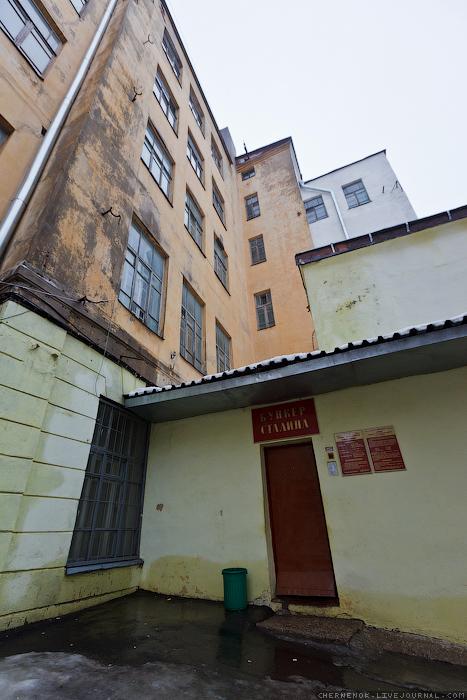
Scheme hopper. Bunker erected best specialists of the country - Moscow metro builders and Donbass miners and ordinary workers. Underground structure was a miniature copy of the Moscow metro station "Airport". In 2900 the building was attended by about 800 workers and engineers and technical workers. Of all the builders of the bunker is now known only to the chief engineer of the project YS Ostrovsky, chief architect MA Zelenin and chief geomarksheyderskih I.I.Drobinin works. All other nameless. From all subscription was taken not to disclose state secrets, which has no statute of limitations. Therefore, even the people living near the city had no idea what was going on behind the high fence construction. The soil was exported machines at night. Builders almost never left the object, ate in the dining room was built here, and spent the night in a hostel in the courtyard of the regional committee or in the underground rooms. Work was carried out around the clock in two shifts. Less than a year was taken out 25 thousand cubic meters of soil, laid 5,000 cubic meters of concrete.
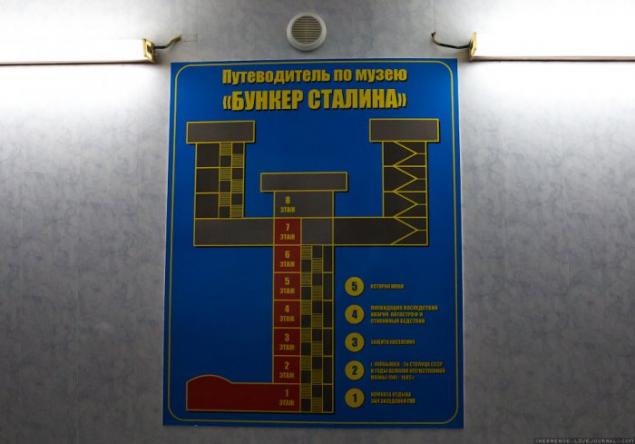
The front door is the upper deck, which begins the descent into the hopper as the elevator and the wall on the stairs.
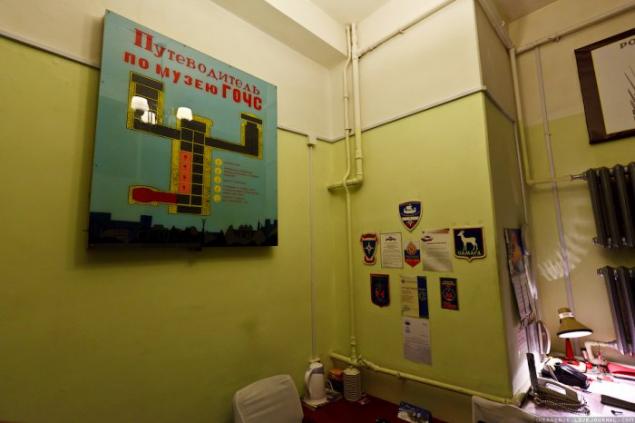
Descent into the bunker started with this 14-meter shaft.
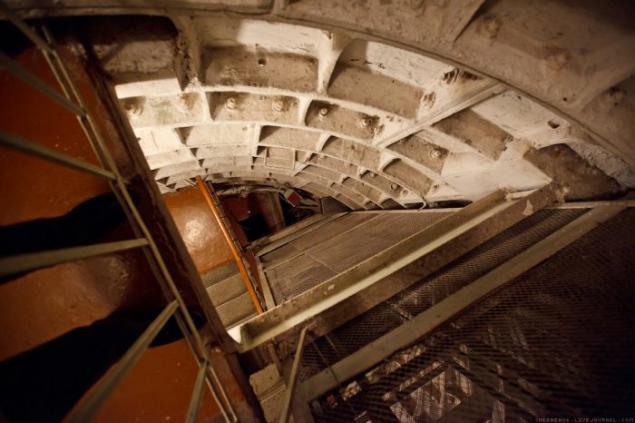
The walls of which are very similar to the subway.
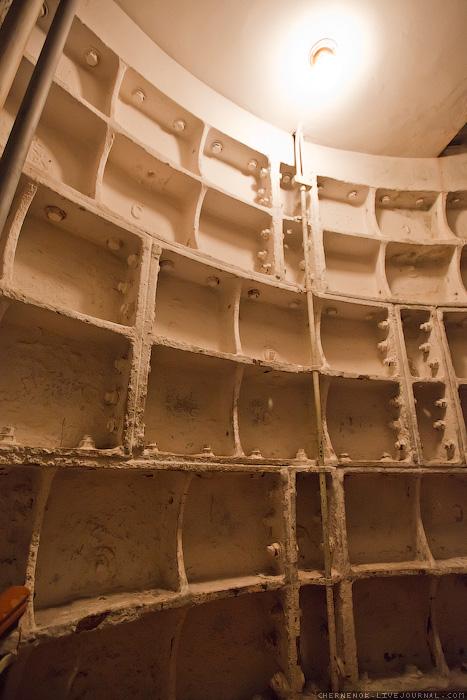
Dropping to 14 meters down we get to the long cross-hallway floor, where the focus units livelihoods and support mechanisms bunker.

Floor-corridor.
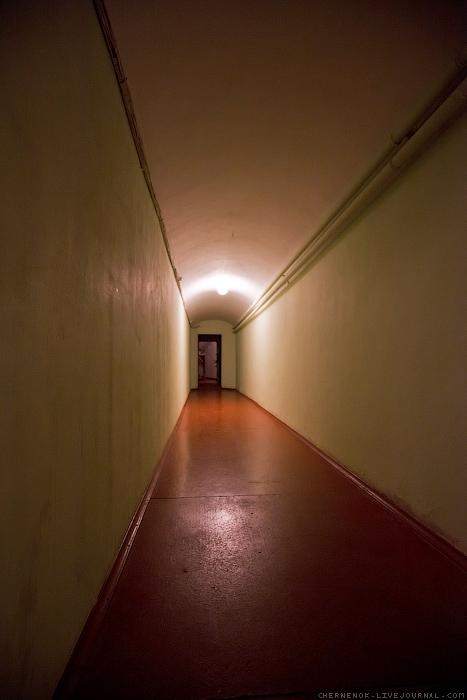
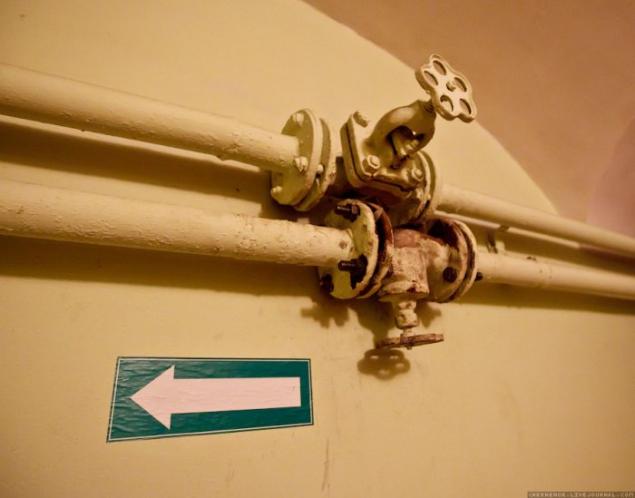
If necessary, the upper floor is covered by massive steel germodveryami capable of withstanding loads up to 10 tons per square meter.
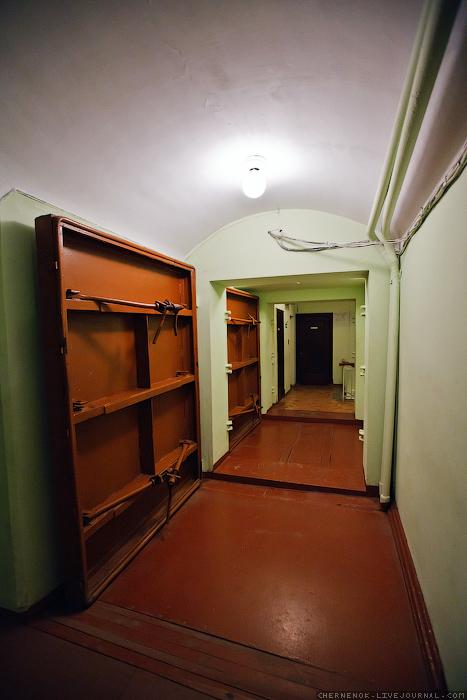
Passing germodveri, we get into the main part of the bunker - vertical shaft refuge, extending into the ground for another 23 meters. He - an exact copy metropolitenovskogo tunnel, vertically. If you omit the descent of the mines, then do not say that you are at a depth of 8-storey building. It seems that you're just in the entrance of the house.

The exhibition "Kuibyshev - 2nd capital of the USSR»
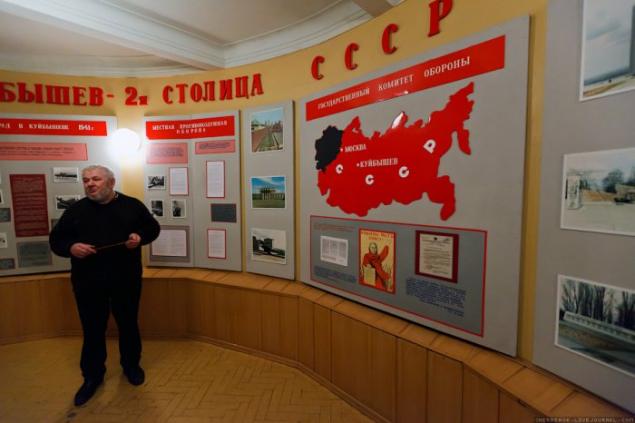
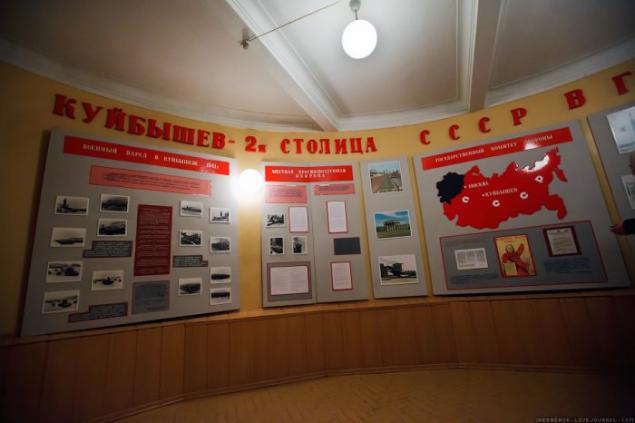
After the 192 th step begins the deepest - first floor (through floors comes from the bottom up).
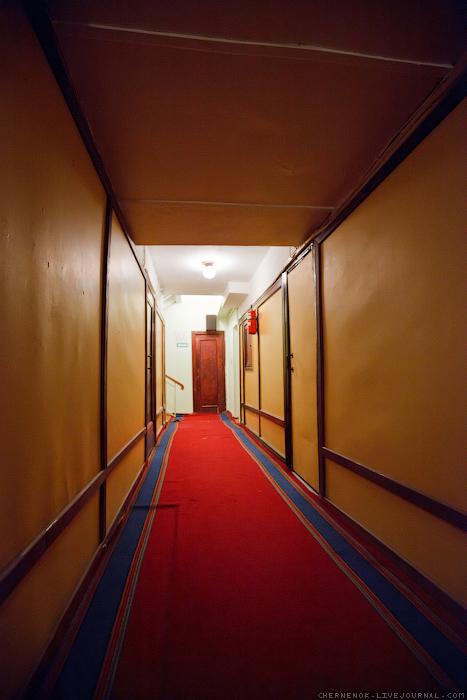
Holy of holies - dayroom Stalin. Vysokosvodnaya - over four meters - it is the style of the Kremlin office of the leader: parquet, oak paneling on the walls, massive table with green cloth, the lamp under a white cap, wall sconces and a symbol of comfort and peace - a sofa in a white cover, so reminiscent of the shroud. Portraits of the two most revered generals Stalin - Suvorov and Kutuzov.
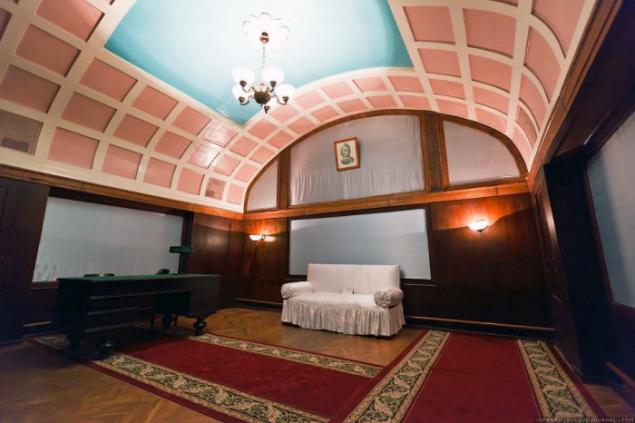
Boardroom government. After the tunnel sites and conciseness Casemate tightness semicircular working rooms fall into a fairly large room with a large T-shaped table; along it - a long table for stenographers, who had to sit with his back to the speakers so as not to see their faces. In the corner at the entrance - tables for the protection of personal secretary and leader Poskrebysheva.
For Stalin's chair - a huge, full-length card fronts the end of 1941.

Underground Stalinist apartment suggest that Chief of Soviet troops from the threat of capture by the Germans in Moscow did not rule out the possibility of moving to Samara. Construction of a secret bunker began in late February 1942. By this time, Kuibyshev, which was evacuated from Moscow, the Soviet government, the apparatus of the Central Committee of the CPSU and 22 foreign missions, officially the spare capital of the Soviet Union. If Moscow was taken by the enemy leadership of military operations would be carried out with the banks of the Volga, possibly from the hopper.


The object is located under the building of the Academy of contemporary art and culture, which previously housed the Kuibyshev Regional Committee. To the right of the main staircase in the lobby of the Regional Party Committee was inconspicuous door, near which the clock duty officer of the NKVD. Immediately after her iron leaf behind which was one of the main secrets of the time. Also, there is an entrance from the courtyard through which we entered.

Stalin's bunker in Samara - the most powerful of the now declassified bunkers. Its depth - 37 meters, the height of a 12-storey building. For comparison, the depth of Hitler's bunker in Berlin is 16 meters, with Churchill in London shelter was located at a depth of only two floors, Roosevelt - also in two. Analogues of such construction was not there, especially if we take into account the time. Giant "hole" was excavated in less than 9 months of continuous work around the clock. In the bunker was an autonomous system of air regeneration and its power. By the way, all this is still in working condition. Hopper to the present day preserve the integrity and is designed for full autonomy for five days. The once-secret dungeon is a multi-storey building, equipped with elevators. On the ground floor there is a conference room for 115 people. Next - Lounge, designed to Stalin. On the upper floors - rooms for security guards, warehouse, service and technical support. Bunker could withstand a direct hit by the biggest aviation bombs that time - above all this structure in situ concrete three meters thick, sand layer and one meter concrete "mattress".

Scheme hopper. Bunker erected best specialists of the country - Moscow metro builders and Donbass miners and ordinary workers. Underground structure was a miniature copy of the Moscow metro station "Airport". In 2900 the building was attended by about 800 workers and engineers and technical workers. Of all the builders of the bunker is now known only to the chief engineer of the project YS Ostrovsky, chief architect MA Zelenin and chief geomarksheyderskih I.I.Drobinin works. All other nameless. From all subscription was taken not to disclose state secrets, which has no statute of limitations. Therefore, even the people living near the city had no idea what was going on behind the high fence construction. The soil was exported machines at night. Builders almost never left the object, ate in the dining room was built here, and spent the night in a hostel in the courtyard of the regional committee or in the underground rooms. Work was carried out around the clock in two shifts. Less than a year was taken out 25 thousand cubic meters of soil, laid 5,000 cubic meters of concrete.

The front door is the upper deck, which begins the descent into the hopper as the elevator and the wall on the stairs.

Descent into the bunker started with this 14-meter shaft.

The walls of which are very similar to the subway.

Dropping to 14 meters down we get to the long cross-hallway floor, where the focus units livelihoods and support mechanisms bunker.

Floor-corridor.


If necessary, the upper floor is covered by massive steel germodveryami capable of withstanding loads up to 10 tons per square meter.

Passing germodveri, we get into the main part of the bunker - vertical shaft refuge, extending into the ground for another 23 meters. He - an exact copy metropolitenovskogo tunnel, vertically. If you omit the descent of the mines, then do not say that you are at a depth of 8-storey building. It seems that you're just in the entrance of the house.

The exhibition "Kuibyshev - 2nd capital of the USSR»


After the 192 th step begins the deepest - first floor (through floors comes from the bottom up).

Holy of holies - dayroom Stalin. Vysokosvodnaya - over four meters - it is the style of the Kremlin office of the leader: parquet, oak paneling on the walls, massive table with green cloth, the lamp under a white cap, wall sconces and a symbol of comfort and peace - a sofa in a white cover, so reminiscent of the shroud. Portraits of the two most revered generals Stalin - Suvorov and Kutuzov.

Boardroom government. After the tunnel sites and conciseness Casemate tightness semicircular working rooms fall into a fairly large room with a large T-shaped table; along it - a long table for stenographers, who had to sit with his back to the speakers so as not to see their faces. In the corner at the entrance - tables for the protection of personal secretary and leader Poskrebysheva.
For Stalin's chair - a huge, full-length card fronts the end of 1941.

Underground Stalinist apartment suggest that Chief of Soviet troops from the threat of capture by the Germans in Moscow did not rule out the possibility of moving to Samara. Construction of a secret bunker began in late February 1942. By this time, Kuibyshev, which was evacuated from Moscow, the Soviet government, the apparatus of the Central Committee of the CPSU and 22 foreign missions, officially the spare capital of the Soviet Union. If Moscow was taken by the enemy leadership of military operations would be carried out with the banks of the Volga, possibly from the hopper.

